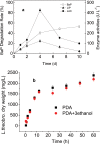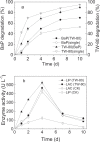Enzyme activities during Benzo[a]pyrene degradation by the fungus Lasiodiplodia theobromae isolated from a polluted soil
- PMID: 31964981
- PMCID: PMC6972742
- DOI: 10.1038/s41598-020-57692-6
Enzyme activities during Benzo[a]pyrene degradation by the fungus Lasiodiplodia theobromae isolated from a polluted soil
Abstract
The enzyme activities of the fungus Lasiodiplodia theobromae (L. theobromae) were studied during degradation of benzo[a]pyrene (BaP). The L. theobromae was isolated from a polycyclic aromatic hydrocarbons (PAHs) contaminated soil collected from the Beijing Coking Plant in China and can potentially use BaP as its sole carbon source with a degradation ratio of up to 53% over 10 days. The activities of lignin peroxidase (LiP) and laccase (LAC) could be detected during BaP biodegradation; while manganese peroxidase (MnP) was not detected. Both glucose and salicylic acid enhanced BaP biodegradation slightly. In contrast, the coexistence of phenanthrene (PHE) inhibited BaP degradation. These metabolic substrates all enhanced the secretion of LiP and LAC. The addition of Tween 80 (TW-80) enhanced BaP biodegradation as well as the LiP and LAC activities. At the same time, TW-80 was degraded by the L. theobromae. In addition, the L. theobromae was compared to Phanerochaete chrysosporium (P. chrysosporium), which is a widely studied fungus for degrading PAH. P. chrysosporium was unable to use BaP as its sole carbon source. The activities of LiP and LAC produced by the P. chrysosporium were less than those of the L. theobromae. Additionally, the four intermediates formed in the BaP biodegradation process were monitored using GC-MS analysis. Four metabolite concentrations first increased and then decreased or obtained the platform with prolonged BaP biodegradation time. Therefore, this study shows that the L. theobromae may be explored as a new strain for removing PAHs from the environment.
Conflict of interest statement
The authors declare no competing interests.
Figures







Similar articles
-
Degradation of PAHs in soil by Lasiodiplodia theobromae and enhanced benzo[a]pyrene degradation by the addition of Tween-80.Environ Sci Pollut Res Int. 2014 Sep;21(18):10614-25. doi: 10.1007/s11356-014-3050-1. Epub 2014 Jun 1. Environ Sci Pollut Res Int. 2014. PMID: 24878554
-
[Isolation of highly-effective benzo[a]pyrene degrading strain and its degradation capacity].Huan Jing Ke Xue. 2011 Sep;32(9):2696-702. Huan Jing Ke Xue. 2011. PMID: 22165241 Chinese.
-
[Bioremediation of PAHs contaminated soil from Beijing coking plant by Lasiodiplodia theobromae].Huan Jing Ke Xue. 2012 Aug;33(8):2832-9. Huan Jing Ke Xue. 2012. PMID: 23213912 Chinese.
-
Biodegradation of polycyclic aromatic hydrocarbons (PAHs) by fungal enzymes: A review.J Environ Sci (China). 2017 Jan;51:52-74. doi: 10.1016/j.jes.2016.08.023. Epub 2016 Oct 3. J Environ Sci (China). 2017. PMID: 28115152 Review.
-
Biodegradation aspects of polycyclic aromatic hydrocarbons (PAHs): a review.J Hazard Mater. 2009 Sep 30;169(1-3):1-15. doi: 10.1016/j.jhazmat.2009.03.137. Epub 2009 Apr 7. J Hazard Mater. 2009. PMID: 19442441 Review.
Cited by
-
Influence of Benzo(a)pyrene on Different Epigenetic Processes.Int J Mol Sci. 2021 Dec 15;22(24):13453. doi: 10.3390/ijms222413453. Int J Mol Sci. 2021. PMID: 34948252 Free PMC article. Review.
-
Thriving in salty environments: Aspergillus niger's halotolerance and BTEX biodegradation potential.World J Microbiol Biotechnol. 2024 Dec 18;41(1):6. doi: 10.1007/s11274-024-04220-7. World J Microbiol Biotechnol. 2024. PMID: 39690259
-
Systemic Identification and Functional Characterization of Common in Fungal Extracellular Membrane Proteins in Lasiodiplodia theobromae.Front Plant Sci. 2021 Dec 20;12:804696. doi: 10.3389/fpls.2021.804696. eCollection 2021. Front Plant Sci. 2021. PMID: 34987541 Free PMC article.
-
Enhanced Remediation of Polycyclic Aromatic Hydrocarbons in Soil Through Fungal Delignification Strategy and Organic Waste Amendment: A Review.Indian J Microbiol. 2025 Jun;65(2):775-797. doi: 10.1007/s12088-024-01383-7. Epub 2024 Sep 9. Indian J Microbiol. 2025. PMID: 40655342 Free PMC article. Review.
-
Enhancing Benzo[a]pyrene Degradation by Pantoea dispersa MSC14 through Biostimulation with Sodium Gluconate: Insights into Mechanisms and Molecular Regulation.Microorganisms. 2024 Mar 15;12(3):592. doi: 10.3390/microorganisms12030592. Microorganisms. 2024. PMID: 38543643 Free PMC article.
References
-
- Juhasz AL, Naidu R. Bioremediation of high molecular weight polycyclic aromatic hydrocarbons: a review of the microbial degradation of benzo[a]pyrene. Int. Biodeterior. Biodegrad. 2000;45:57–88. doi: 10.1016/S0964-8305(00)00052-4. - DOI
-
- Ye B, Siddiqi MA, Maccubbin AE, Kumar S, Sikka HC. Degradation of polynuclear aromatic hydrocarbons by Sphingomonas paucimobilis. Environ. Sci. Technol. 1996;30:136–142. doi: 10.1021/es9501878. - DOI
Publication types
MeSH terms
Substances
LinkOut - more resources
Full Text Sources
Miscellaneous

